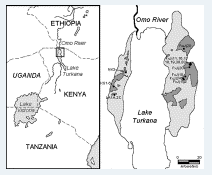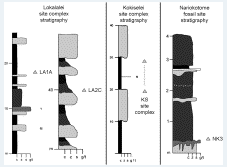Rhonda L. Quinn, Christopher J. Lepre, Craig S. Feibel, James D. Wright, Richard A. Mortlock, Sonia Harmand, Jean-Philip Brugal, Hélène Roche
Source - http://www.sciencedirect.com/science/article/pii/S0047248413000997
Journal of Human Evolution , Volume 65, Issue 1, July 2013, Pages 65–78
Abstract
The origin and evolution of early Pleistocene hominin lithic technologies in Africa occurred within the context of savanna grassland ecosystems. The Nachukui Formation of the Turkana Basin in northern Kenya, containing Oldowan and Acheulean tool assemblages and fossil evidence for early members of Homo and Paranthropus, provides an extensive spatial and temporal paleosol record of early Pleistocene savanna flora. Here we present new carbon isotopic (δ13CVPDB) values of pedogenic carbonates (68 nodules, 193 analyses) from the Nachukui Formation in order to characterize past vegetation structure and change through time. We compared three members (Kalochoro, Kaitio, and Natoo) at five locations spanning 2.4–1.4 Ma and sampled in proximity to hominin archaeological and paleontological sites. Our results indicate diverse habitats showing a mosaic pattern of vegetation cover at each location yet demonstrate grassland expansion through time influenced by paleogeography. Kalochoro floodplains occurred adjacent to large river systems, and paleosols show evidence of C3 woodlands averaging 46–50% woody cover. Kaitio habitats were located along smaller rivers and lake margins. Paleosols yielded evidence for reduced portions of woody vegetation averaging 34–37% woody cover. Natoo environments had the highest percentage of grasslands averaging 21% woody cover near a diminishing Lake Turkana precursor. We also compared paleosol δ13CVPDB values of lithic archaeological sites with paleosol δ13CVPDB values of all environments available to hominins at 2.4–1.4 Ma in the Nachukui and Koobi Fora Formations. Grassy environments became more widespread during this interval; woody canopy cover mean percentages steadily decreased by 12%. However, significantly more wooded savanna habitats were present in the vicinity of lithic archaeological sites and did not mirror the basin-wide trend of grassland spread. Hominin lithic archaeological sites consistently demonstrated woody cover circa 40% throughout our study interval and were 4–12% more woody than coeval basin environs. We propose that Turkana Basin early tool makers may have preferred a more wooded portion of the savanna ecosystem to reduce heat stress and to gain differential access to potable water, raw materials, animal carcasses, and edible plants.

Figure 1. Left: location map of the Turkana Basin in northern Kenya, East Africa; right: map of Nachukui and Koobi Fora Formations in the Turkana Basin. Shaded areas denote collecting locations of all sampled paleosols for isotopic analysis in the basin (data from Cerling et al., 1988; Wynn, 2004; Quinn et al., 2007; Passey et al., 2010; Levin et al., 2011; this study). Dots show locations of paleosols sampled for isotopic analysis at lithic sites (data from Quinn et al., 2007; Levin et al., 2011; this study).

Figure 3. Stratigraphic sections of the Lokalalei (LA1A, LA2C) and Kokiselei (KS1-6 Complex) lithic archaeological sites and the Nariokotome (NK3) paleontological site. Key: M, molluscan fauna; V, tuffaceous; c, clay; z, silt; s, sand; g/t, gravel, tuff; black, clay/paleosol; dark gray, silt; medium gray, tuff; light gray, sand; white, carbonate.